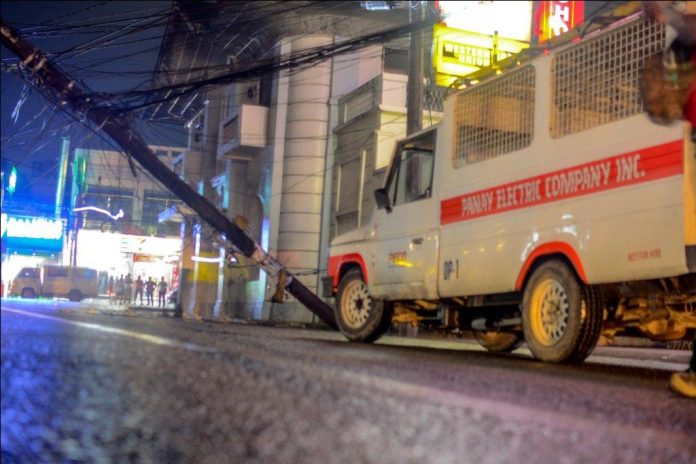
ILOILO City – Panay Electric Co. (PECO) denied specifically attributing pole fires here to the Philippine Long Distance Telephone Co. (PLDT).
“We merely stated that of the reported 709 pole fires from 2017 to 2019, only 138 were PECO-related. With that logic in mind, the remainder of the pole fires must related to telcos,” PECO stated in a letter to PLDT Panay Customer Service Zone senior manager Rene Lescano.
According to PECO, never in their statements in the media nor in their report to the Energy Regulatory Commission (ERC) did they state that the 571 pole fires in this city were attributable to PLDT.
The other day, Lescano said it was “not correct to say that the more than 500 posts are ours. We have very few wooden poles compared to (PECO’s).”
On Lescano’s assertion that PLDT’s lines were without voltage, PECO stated that one of the most common causes of pole fires is when telecommunication equipment attached to PECO poles short circuit. This occurs when a linkage is created between telco lines and/or messenger wires and PECO’s secondary, service lines and/or pole groundings.
“This can happen especially when telcos install pole clamps without insulators on PECO poles for their messenger wire, and this un-insulated clamp touches PECO’s pole grounding wire,” according to PECO.
PECO’s letter to PLDT was signed by Administrative Manager Marcelo Cacho, Line Engineer Mark Sejob and Operations Manager for Planning Engineer Aldren Deleste.
PECO also attached a sample voltage test of a telco messenger wire that has come in contact with a PECO secondary line. The voltages were 157V, 156V and 70V, respectively.
“In light of these results, we would like to immediately request that all PLDT facilities with attachments to PECO poles be installed with insulated pole clamps. We would like you to submit within 15 days a timeline in which you can install insulated pole clamps for all your attachments on PECO poles,” read part of PECO’s letter.
PECO also urged PLDT contractors not to bundle their wires with PECO’s wires as this may cause fire, especially when GI wires are used to bundle the said lines, as these are conductors that can create short circuit as well.
PECO said it is standard procedure that there should be a gap between electrical wires and telco lines.
As to the poles on roads affected by road widening and could not be removed due to PLDT cable attachments, PECO asked the telco to immediately remove its facilities from their old poles in the following sites: four poles in Barangay Calajunan, Mandurriao district and two poles by the Rizal Bridge.
“We have been unable to remove our poles despite having relocated our facilities already due to PLDT’s facilities, which are still attached to them,” PECO added.
Regarding wires that are extremely low-hanging and have not been attached to new poles, PECO told PLDT to review their wiring set up in the areas of Barangay Caingin (La Paz), Barangay Baluarte (Molo) and Burgos Street, La Paz, among other streets.
“These areas have extremely low-hanging wires that are mistaken to be PECO wires and are a danger to the community. We have surveyed these and they do not belong to us. The same go with boxes in the middle of the street; one in Barangay Mansaya, La Paz has already been bumped and yet has not been removed,” PECO cited with attached photos as proof.
As the to lack of emergency line team to resolve issues, PECO turned the table to PLDT and its lack of available line teams to attend to emergencies caused by their own leaning and/or fallen poles.
“We have experienced multiple instances wherein our line teams have had to correct leaning or fallen PLDT poles that are blocking roads and creating traffic,” PECO stressed.
They cited for instance, the incident in Jaro Plaza in front of the Archbishop’s Palace on Nov. 13 wherein PECO’s team had to temporarily fix the PLDT pole.
To this date, the said pole has not yet been removed or repaired, said PECO attaching photo of it.
Another instance, among others, happened in Barangay Kasing-kasing, Molo on Nov. 7, wherein a pole fell on the road and no emergency personnel came from PLDT to rectify it. PECO sent its troubleshooters to move the pole to avoid traffic congestion.
“These are just a few of the incidents when we had to troubleshoot your facilities. While we readily do these jobs in the interest of public safety and uninterrupted traffic flow, we hope you can provide teams to maintain and troubleshoot your own facilities,” PECO told PLDT.
Lastly, PECO invited Lescano to attend the next Iloilo Utilities Group meeting on Nov. 27, 2 p.m. at the the PECO Annex H.
“You have not been to our meetings in almost two years; the other members of the other group may have concerns to relay to you in light of the challenges and opportunities posed by the many development projects in Iloilo City,” said PECO./PN



